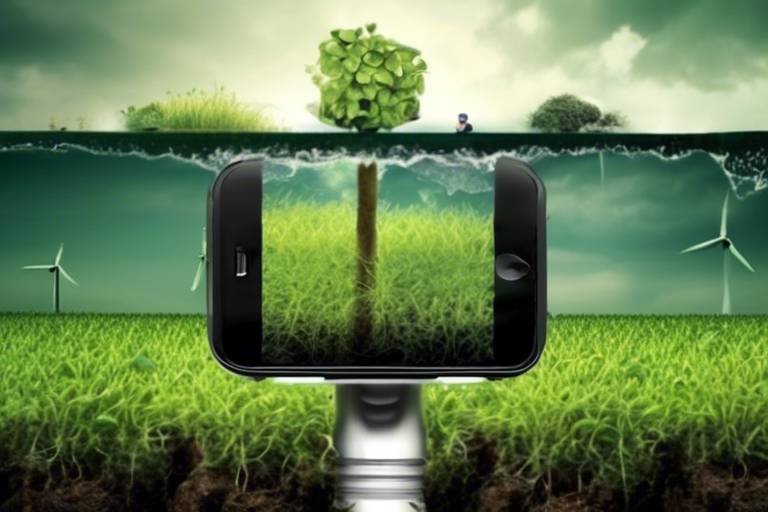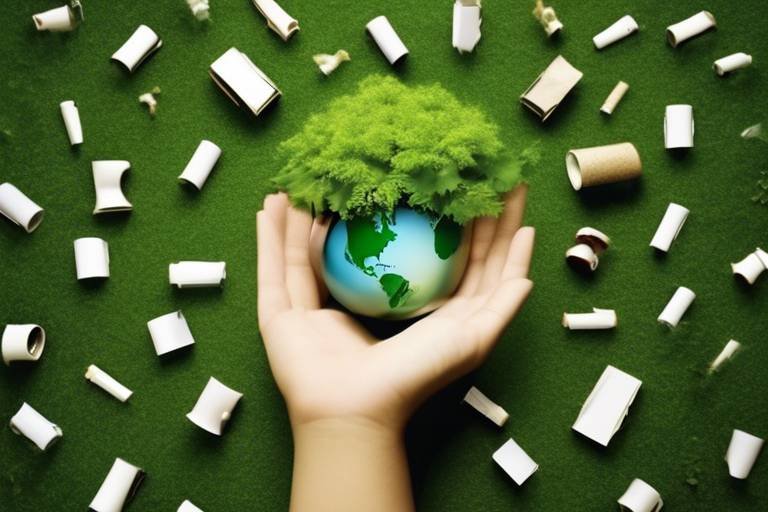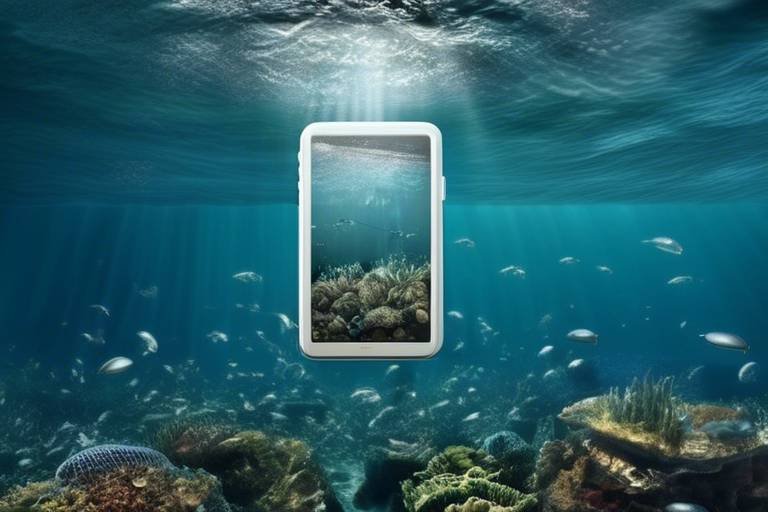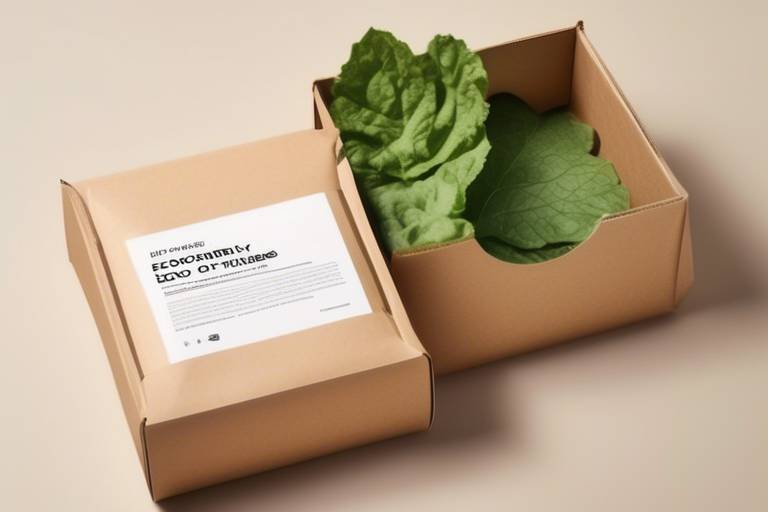Unraveling Eco-Friendly Myths - Fact or Fiction?
In today's world, the term eco-friendly is thrown around like confetti at a parade. It seems like everyone is trying to do their part to save the planet, but how much do we really know about what it means to be environmentally conscious? Many people hold onto certain beliefs about sustainable practices that might not be entirely true. This article sets out to unravel these myths, separating fact from fiction, and providing clarity on what sustainable living truly entails.
As we dive into this topic, it's essential to recognize that the journey toward a greener lifestyle is filled with twists and turns. Just like navigating through a dense forest, it can be challenging to find the right path. Some myths may seem harmless, while others can lead us astray, causing more harm than good. So, buckle up as we explore the most common misconceptions surrounding eco-friendly practices.
Understanding these myths is crucial because they can shape our behaviors and decisions. For instance, if we believe that all organic products are inherently good for the environment, we might overlook other important factors such as packaging, transportation, and local sourcing. By shining a light on these misconceptions, we can make more informed choices that truly benefit our planet.
Throughout this article, we'll address several myths, including the idea that recycling is a catch-all solution, the environmental impact of electric cars, and the real meaning behind organic products. By the end, you’ll not only have a clearer understanding of what it means to live sustainably but also feel empowered to take actionable steps toward a greener future.
- What is the most common eco-friendly myth? Many people believe that all organic products are automatically good for the environment, which is not always the case.
- Is recycling enough to solve our waste problems? No, recycling is important, but reducing waste at the source is even more critical.
- Are electric cars truly better for the environment? While they have lower emissions during use, the production and disposal of their batteries can have significant environmental impacts.
- What can I do to reduce my waste? Consider composting, opting for reusable products, and being mindful of your consumption habits.

Myth 1: All Organic Products Are Eco-Friendly
When we hear the term organic, many of us instinctively think of products that are not only healthier for us but also better for the environment. It's easy to believe that if something is labeled as organic, it must be eco-friendly. However, the truth is far more nuanced. While organic farming practices do aim to reduce the use of synthetic pesticides and fertilizers, they aren't a straightforward solution to all environmental issues. For example, the cultivation of organic crops can still lead to significant land use, water consumption, and even soil degradation if not managed properly.
Moreover, the transportation of organic products can contribute to their carbon footprint. Many organic goods are imported from far-flung places, leading to increased greenhouse gas emissions during transit. So, while you might be doing your part by choosing organic, it's essential to consider the entire lifecycle of these products. Are they local? Are they seasonal? These questions can help you make more informed choices that truly benefit the environment.
Let's break it down a bit further. Here are some factors to consider when evaluating whether organic products are genuinely eco-friendly:
- Farming Practices: Not all organic farms are created equal. Some may still engage in practices that harm the environment, such as monoculture farming, which depletes soil nutrients.
- Water Usage: Organic farming can be water-intensive. The impact on local water resources can be significant, especially in drought-prone areas.
- Packaging: Many organic products come in non-recyclable packaging, which contributes to waste issues.
So, next time you're at the grocery store, consider the broader implications of your choices. Just because something is labeled organic doesn’t automatically make it the best choice for the planet. Instead, look for products that are not only organic but also locally sourced and sustainably packaged. This holistic approach can make a real difference in reducing your environmental footprint.
In conclusion, while organic products can be part of a sustainable lifestyle, they are not a silver bullet. It's crucial to educate ourselves about the complexities of organic farming and make conscious choices that align with our environmental values. By doing so, we can contribute to a more sustainable future without falling prey to the myth that organic equals eco-friendly.

Myth 2: Recycling Solves All Waste Problems
Many of us have been led to believe that simply tossing our plastic bottles and cardboard boxes into the recycling bin is the end of our environmental responsibility. However, the truth is that recycling is just one piece of a much larger puzzle when it comes to waste management. While it plays a vital role in reducing the volume of waste that ends up in landfills, it is not a cure-all for the myriad of waste problems we face today.
To grasp the limitations of recycling, we need to understand that not all materials are recyclable, and even those that are can only be recycled a limited number of times before they lose their integrity. For instance, paper can only be recycled about five to seven times, after which the fibers become too short to be reused effectively. This means that if we rely solely on recycling without addressing the root causes of our waste generation, we may still find ourselves in a precarious situation.
Moreover, the recycling process itself can be energy-intensive and may produce emissions that are harmful to the environment. The collection, sorting, and processing of recyclables require significant resources. In fact, a study by the Environmental Protection Agency (EPA) revealed that the recycling process can sometimes emit more greenhouse gases than landfilling, depending on the materials and methods used. So, while recycling is certainly better than throwing everything away, it’s not the ultimate solution.
Understanding the significance of waste reduction can lead to more sustainable behaviors. Instead of focusing solely on recycling, we should prioritize reducing waste at the source. This means being mindful of our consumption habits and making conscious choices to minimize the amount of waste we generate in the first place. For example, consider the impact of single-use plastics. By choosing to bring your own bags, bottles, and containers, you can significantly cut down on the waste produced from these disposable items.
Another effective way to reduce waste is through composting. This process not only diverts organic waste from landfills but also creates nutrient-rich soil for gardens. By composting kitchen scraps and yard waste, you can reduce methane emissions from landfills, which is a potent greenhouse gas. Composting is a simple yet powerful way to contribute to a healthier environment while also enriching your garden.
Opting for reusable products can significantly decrease waste. Consider alternatives to common disposable items:
- Reusable water bottles instead of single-use plastic bottles
- Cloth bags instead of plastic shopping bags
- Metal straws instead of plastic ones
By making these small changes in our daily lives, we can collectively make a big difference in reducing waste.
Many people are unaware of what happens to recyclables after collection. The journey from your recycling bin to the recycling facility is often complicated and fraught with challenges. Once collected, recyclables are sorted, cleaned, and processed. However, contamination can pose a significant problem. If non-recyclable materials end up in the recycling bin, they can spoil entire batches of recyclables, rendering them unusable.
In summary, while recycling is an important part of waste management, it is not the silver bullet that many believe it to be. By focusing on reducing waste and making sustainable choices, we can create a more effective and comprehensive approach to protecting our planet.
Q: Can all plastics be recycled?
A: No, not all plastics are recyclable. Check local guidelines to know which types are accepted.
Q: Is composting difficult?
A: Not at all! Composting can be as simple as setting up a bin for your kitchen scraps and yard waste.
Q: What happens to my recyclables after they are collected?
A: After collection, recyclables are sorted, cleaned, and processed into new materials. However, contamination can lead to significant issues.

The Importance of Reducing Waste
Reducing waste is not just a trendy catchphrase; it’s a vital practice that can lead to significant improvements in our environment. Think of it like trimming the fat off a steak—by cutting away the excess, you get to the juicy, nutritious part. In the same way, by minimizing waste, we can focus on what truly matters: a healthier planet. When we talk about waste reduction, we’re not just addressing the piles of trash we see in landfills; we’re also tackling the entire lifecycle of products we consume.
One of the biggest misconceptions is that recycling alone can solve our waste problems. While recycling is important, it’s like putting a Band-Aid on a larger wound. The reality is that the best way to make a positive impact is to reduce the amount of waste we create in the first place. This proactive approach can lead to a ripple effect, influencing our behaviors and encouraging others to follow suit. By adopting a mindset of waste reduction, we can foster a culture of sustainability that extends beyond our individual actions.
Consider this: every item we purchase has a footprint, from the resources used in production to the energy consumed during transportation. By reducing our consumption, we can significantly lower demand for these resources and, consequently, the waste generated. For instance, opting for quality over quantity in our purchases not only benefits our wallets but also minimizes environmental impact. When we choose durable products, we reduce the frequency of replacements and the waste associated with them.
Moreover, reducing waste can be a fun and rewarding challenge. Think of it as a game where the goal is to outsmart consumerism. You can start by asking yourself a few simple questions before making a purchase: Do I really need this? Can I borrow or rent it instead? Is there a reusable option available? These small inquiries can lead to more mindful decisions that ultimately contribute to a larger cause.
In addition to personal choices, there are community efforts that can amplify the impact of waste reduction. Participating in local clean-up events or supporting initiatives that promote zero-waste lifestyles can create a collective force for change. When we come together as a community, we not only amplify our individual efforts but also inspire others to join the movement.
In summary, reducing waste is an essential component of sustainable living. It encourages us to rethink our consumption habits and take responsibility for our environmental footprint. By focusing on waste reduction, we can create a cleaner, healthier world for future generations. So, let’s roll up our sleeves and get to work—every little bit counts!
- What are some easy ways to reduce waste at home? Start by implementing the three R's: Reduce, Reuse, and Recycle. Opt for reusable bags, containers, and bottles, and compost organic waste.
- Is reducing waste really impactful? Absolutely! Even small changes can lead to significant reductions in waste and resource consumption over time.
- How can I encourage others to reduce waste? Share your experiences and tips on social media, organize community events, or simply lead by example in your daily life.

Composting as a Solution
Composting is not just a trendy buzzword; it's a practical and effective solution for reducing organic waste that benefits both the environment and your home garden. Imagine turning your kitchen scraps and yard waste into rich, fertile soil that nourishes your plants. It’s like giving back to the earth while simultaneously decluttering your trash can. But how does composting work, and why should you consider it?
At its core, composting is the natural process of recycling organic material, such as food scraps and yard waste, into a valuable fertilizer known as compost. This process not only reduces the amount of waste sent to landfills but also enriches the soil, helping plants thrive. When organic materials decompose, they release nutrients that are essential for plant growth, making compost a powerhouse for any garden.
One of the most significant advantages of composting is its ability to reduce methane emissions. When organic waste decomposes anaerobically (without oxygen) in landfills, it produces methane, a greenhouse gas far more potent than carbon dioxide. By composting, we can prevent this harmful gas from entering the atmosphere. Instead, composting promotes aerobic decomposition, which is much cleaner and more efficient.
To get started with composting, you don’t need a lot of fancy equipment. A simple compost bin in your backyard or even a small container in your kitchen can do the trick. You can compost a variety of materials, including:
- Fruit and vegetable scraps
- Eggshells
- Coffee grounds and filters
- Grass clippings
- Leaves and small branches
However, it’s essential to avoid composting certain items, such as meat, dairy, and oils, as they can attract pests and create odors. By being mindful of what you include in your compost, you can create a balanced mix that breaks down efficiently.
Another fantastic aspect of composting is that it helps you save money. Instead of purchasing chemical fertilizers, you can produce your own nutrient-rich compost at home. Plus, it’s an excellent way to engage children in environmental education, teaching them the importance of waste reduction and sustainable practices.
In summary, composting is a simple yet powerful tool in our quest for a more sustainable lifestyle. It's not just about reducing waste; it's about creating a cycle of nourishment that benefits the earth and our gardens alike. So, next time you’re about to toss those vegetable peels in the trash, think twice! You could be nurturing the soil instead.

Choosing Reusable Over Disposable
In a world increasingly aware of environmental issues, the choice between reusable and disposable products has never been more crucial. Imagine walking into a store and reaching for a plastic bag, only to realize that each bag you use contributes to a growing mountain of waste. Now, picture instead grabbing a sturdy, reusable tote that not only helps you carry your groceries but also reduces your carbon footprint. It's a small change, but it can lead to significant impacts over time.
One of the most compelling reasons to choose reusable items is their ability to drastically cut down on waste. Consider this: a single reusable shopping bag can replace hundreds, if not thousands, of plastic bags over its lifetime. The environmental benefits are clear, but the personal benefits shouldn't be overlooked either. Reusable products often prove to be more durable and cost-effective in the long run. For instance, investing in a high-quality stainless steel water bottle can save you money compared to buying bottled water daily.
It's also essential to recognize that the shift toward reusables can extend beyond just bags and bottles. Here are a few more examples of how you can incorporate reusable alternatives into your daily life:
- Food Storage: Instead of single-use plastic wrap, opt for beeswax wraps or glass containers.
- Straws: Ditch disposable straws for stainless steel or silicone ones that can be washed and reused.
- Utensils: Carry a set of reusable utensils in your bag to avoid the need for disposable cutlery when eating on the go.
Moreover, the psychological shift that comes with choosing reusables is profound. When you consciously decide to use a reusable item, you're not just making a purchase; you're making a statement about your values and priorities. It fosters a sense of responsibility and encourages others around you to consider their choices as well. It's like starting a ripple effect—one person's decision can inspire a community to rethink their habits.
However, it's important to acknowledge that switching to reusable products isn't always straightforward. Some people may feel overwhelmed by the options or unsure of where to start. The key is to take it one step at a time. Begin by replacing just one disposable item in your daily routine with a reusable version. As you become more comfortable, gradually expand your collection. Remember, every little bit counts, and even small changes can lead to significant positive outcomes for our planet.
In conclusion, choosing reusable over disposable is not just a trend; it's an essential lifestyle change that can have lasting effects on the environment. By making mindful choices, you contribute to a healthier planet and set an example for others. So, the next time you're about to reach for that single-use item, pause and think: is there a reusable alternative that I can use instead?

Understanding the Recycling Process
When you toss that plastic bottle into the recycling bin, what happens next? Many people have a vague idea that their recyclables get transformed into something new, but the truth is often much more complex. Understanding the recycling process is crucial for anyone looking to make a genuine impact on waste reduction. It’s not just about tossing things in a bin; it’s about knowing the journey those materials take after they leave your hands.
The recycling process begins at the curbside, where your recyclables are collected and transported to a materials recovery facility (MRF). Here, workers sort through the items, separating them based on material type. This step is vital because different materials require different processing techniques. For instance, metals, plastics, and paper all have unique recycling methods. However, it's not as simple as it sounds; contamination can derail the entire process. If your pizza box is covered in grease or your plastic bottle still has remnants of soda, these items can compromise the quality of the recycling stream.
Once sorted, the materials are compressed and baled, making them easier to transport to recycling plants. At these facilities, the real magic happens. The materials undergo various processes depending on their type:
- Plastics: They are shredded, melted down, and then reformed into pellets that can be used to create new plastic products.
- Metals: Aluminum and steel are melted down and poured into molds to create new items.
- Paper: It’s pulped, cleaned, and reformed into sheets of new paper products.
Despite these processes, recycling still faces significant challenges. One of the biggest hurdles is the fluctuating market demand for recycled materials. When demand is low, recycling programs can become economically unsustainable, leading to more materials ending up in landfills. Additionally, the complexity of modern products, which often contain multiple materials, makes recycling more difficult. As consumers, understanding these challenges can empower us to make better choices about what we recycle.
So, how can you play a role in improving the recycling process? It starts with being mindful of what you place in your recycling bin. Always rinse out containers to reduce contamination and familiarize yourself with local recycling guidelines. Some communities have specific rules about what can and cannot be recycled, and adhering to these can significantly enhance the efficiency of the recycling process.
In conclusion, while recycling is a critical component of waste management, it is not a silver bullet. By understanding the complexities of the recycling process, we can all contribute to a more sustainable future. Remember, the journey doesn’t end at the recycling bin; it’s just the beginning!
Q: What can I recycle?
A: It varies by location, but common items include paper, cardboard, glass, and certain plastics. Always check your local guidelines.
Q: What happens if I recycle contaminated items?
A: Contaminated recyclables can spoil entire batches, leading to more waste. Always rinse containers before recycling.
Q: Is recycling really worth it?
A: Yes, recycling conserves resources, reduces landfill waste, and can decrease pollution. However, reducing and reusing are even more effective!
Q: Can I recycle plastic bags?
A: Most curbside recycling programs do not accept plastic bags. Many grocery stores have designated bins for recycling them.

Myth 3: Electric Cars Are Always Better for the Environment
When you think of electric cars, what comes to mind? For many, it's the image of a futuristic vehicle gliding silently down the road, leaving behind nothing but a whisper of clean air. It's easy to fall into the trap of believing that electric vehicles (EVs) are the ultimate solution to our environmental woes. However, the reality is a bit more complicated. While electric cars do offer some significant benefits, they aren't a silver bullet for environmental issues. In fact, their overall impact on the environment can vary greatly depending on several factors.
First, let’s talk about the lifecycle of electric vehicles. From production to disposal, every stage has its own environmental implications. For instance, the manufacturing of electric cars, particularly the batteries, can be quite resource-intensive. The extraction of lithium, cobalt, and other materials required for batteries often involves mining practices that can cause severe environmental degradation. Not only does this mining process disrupt local ecosystems, but it also raises ethical concerns regarding labor practices in some regions.
Moreover, the environmental impact doesn’t stop once the car is on the road. The source of the electricity used to charge these vehicles plays a crucial role in determining their overall emissions. If the electricity comes from fossil fuels, the carbon footprint can be surprisingly high. In fact, a study showed that in areas where coal is the primary energy source, electric cars can produce more emissions than their gasoline counterparts. This might sound shocking, but it underscores the importance of considering where your energy is coming from.
Now, let’s dive deeper into the battery production and disposal aspects. The production of EV batteries not only requires a significant amount of energy but also generates a considerable amount of waste. And what happens when these batteries reach the end of their life? Unfortunately, improper disposal can lead to toxic materials leaking into the environment, which poses risks to both human health and wildlife. While there are efforts to recycle EV batteries, the technology and infrastructure for doing so are still developing.
When comparing emissions, it’s essential to look at the entire picture. While electric cars typically have zero tailpipe emissions, we must consider the emissions associated with their production and the energy used to charge them. The table below summarizes the emissions from both electric and traditional vehicles:
| Vehicle Type | Average CO2 Emissions (g/km) | Notes |
|---|---|---|
| Gasoline Car | 120-180 | Varies by model and fuel efficiency |
| Electric Car | 50-150 | Depends on energy source for electricity |
As you can see, the emissions from electric vehicles can be significantly lower, but they are not always negligible. It’s crucial for consumers to do their homework and understand the broader implications of their choices. So, while electric cars can certainly be part of the solution to reducing greenhouse gas emissions, they are not the ultimate answer to our environmental challenges.
In conclusion, electric cars are a step in the right direction, but they come with their own set of challenges. It’s vital for us to remain informed and critical about our choices. By understanding the complexities involved, we can make better decisions not only for ourselves but also for the planet. Remember, sustainable living is about more than just choosing one type of vehicle; it’s about adopting a comprehensive approach that considers all aspects of our consumption and lifestyle.
- Are electric cars really better for the environment? - It depends on various factors, including how the electricity is generated and the environmental impact of battery production and disposal.
- What happens to electric car batteries when they are no longer usable? - If not recycled properly, they can contribute to environmental pollution. However, recycling efforts are improving.
- How can I ensure my electric vehicle is environmentally friendly? - Consider the energy source for charging and support renewable energy initiatives.

Battery Production and Disposal
The environmental impact of electric vehicles (EVs) is often simplified to the notion that they are inherently better for the planet than traditional gas-powered cars. However, a crucial aspect that is frequently overlooked is the production and disposal of their batteries. These batteries, primarily lithium-ion, are not only essential for the vehicle's performance but also come with a significant environmental cost. The extraction of lithium, cobalt, and nickel—the key components of these batteries—can lead to devastating ecological consequences. For instance, mining operations can result in habitat destruction, water pollution, and increased carbon emissions.
Furthermore, the production process itself is energy-intensive. It requires considerable amounts of electricity, often sourced from fossil fuels, which can negate some of the environmental benefits that EVs offer. To put this into perspective, a study by the International Council on Clean Transportation revealed that the production of an electric vehicle can generate up to 68% more greenhouse gas emissions than a conventional car, primarily due to battery manufacturing.
Once these batteries reach the end of their life cycle, the challenges continue. Many consumers are unaware of the proper disposal methods for used EV batteries. If not handled correctly, these batteries can leach harmful chemicals into the soil and groundwater, posing risks to both human health and the environment. Currently, only about 5% of lithium-ion batteries are recycled, which means the majority end up in landfills, contributing to the growing problem of electronic waste.
To mitigate these issues, advancements in battery technology and recycling methods are crucial. For example, companies are investing in closed-loop recycling processes that can recover up to 95% of the materials used in lithium-ion batteries. This not only reduces the need for new raw materials but also minimizes the environmental impact associated with mining. Additionally, as technology evolves, we might see the emergence of alternative battery technologies that are less harmful to the environment.
In conclusion, while electric vehicles present a promising alternative to fossil fuel-powered cars, it is essential to consider the entire lifecycle of their batteries. From production to disposal, the environmental implications are significant and warrant a more nuanced discussion about the true sustainability of electric vehicles.
- What materials are used in electric vehicle batteries? Electric vehicle batteries primarily use lithium, cobalt, and nickel.
- How are electric vehicle batteries recycled? Many companies are developing closed-loop systems to recover materials from used batteries, significantly reducing waste.
- Are electric vehicles really better for the environment? While they produce zero emissions while driving, the environmental impact of battery production and disposal must also be considered.

Comparing Emissions
When it comes to assessing the environmental impact of vehicles, the conversation often shifts towards emissions. Many people assume that electric cars are the ultimate solution to reducing our carbon footprint, but the reality is a bit more complicated. To truly understand the benefits, we need to compare the emissions of electric vehicles (EVs) with those of traditional gasoline-powered cars.
First, let’s examine the emissions produced during the operation of these vehicles. Electric cars are celebrated for their zero tailpipe emissions. This means that while you’re cruising down the highway in your sleek EV, you’re not directly releasing harmful pollutants into the air. However, the story doesn’t end there. The electricity that powers these vehicles often comes from sources that can produce significant emissions, such as coal or natural gas. Therefore, the overall impact of an electric car largely depends on the energy mix of the region where it is charged.
On the other hand, traditional cars emit greenhouse gases directly from their exhaust systems. According to the Environmental Protection Agency (EPA), the average passenger vehicle emits about 4.6 metric tons of carbon dioxide (CO2) per year. This figure can vary based on factors like fuel efficiency and driving habits, but it gives us a baseline for comparison.
To further illustrate this, let's take a look at a comparison of emissions over a typical driving range:
| Vehicle Type | Annual CO2 Emissions (Metric Tons) | Source of Energy |
|---|---|---|
| Gasoline Car | 4.6 | Gasoline |
| Electric Vehicle | Varies (0 - 2.0 depending on energy source) | Electricity (depends on the grid) |
As seen in the table, the emissions from electric vehicles can be significantly lower, especially in regions where renewable energy sources like wind or solar power dominate the grid. However, it’s crucial to consider the entire lifecycle of the vehicle, including manufacturing and disposal. The production of electric vehicle batteries, for instance, can be energy-intensive and may lead to considerable emissions if not managed properly.
When we compare the total emissions from both types of vehicles over their lifetimes, we must also factor in the emissions associated with battery production. A study by the Nature Energy Journal highlighted that while EVs generally have a lower carbon footprint during their operational phase, the upfront emissions from battery production can offset some of those benefits, particularly if the battery is not recycled effectively.
In conclusion, while electric cars present a promising alternative to traditional vehicles in terms of reducing operational emissions, the full picture is more nuanced. Factors such as the source of electricity, battery production, and disposal practices must all be taken into account when determining which option is truly better for the environment. It’s a classic case of needing to look beyond the surface to understand the deeper implications of our choices. So, the next time someone tells you that electric cars are the perfect solution, you might want to ask them about the whole story!
- Are electric cars really better for the environment? Yes, but it depends on the energy sources used for electricity and the lifecycle emissions of the vehicle.
- What are the main sources of emissions from electric vehicles? The primary sources include battery production, electricity generation, and vehicle manufacturing.
- Can I reduce my carbon footprint by driving an electric vehicle? Absolutely! However, consider your local energy mix and the sustainability of battery production.
Frequently Asked Questions
- Are all organic products truly eco-friendly?
Not necessarily! While organic products are grown without synthetic pesticides and fertilizers, their environmental impact can vary. Factors like transportation, packaging, and farming practices all play a role in determining how eco-friendly a product really is.
- Does recycling eliminate all waste problems?
Recycling is a vital part of waste management, but it’s not a complete solution. It’s important to focus on reducing waste at the source. By minimizing consumption and opting for sustainable alternatives, we can significantly lessen our environmental footprint.
- What are some effective ways to reduce waste?
There are many proactive measures you can take! Consider composting your organic waste, choosing reusable products over disposables, and being mindful of your purchasing habits. Each small change can lead to a big difference!
- How does composting benefit the environment?
Composting helps divert organic waste from landfills, reducing methane emissions. It also enriches soil, promotes healthy plant growth, and decreases the need for chemical fertilizers, making it a win-win for both your garden and the planet!
- Are electric cars always better for the environment?
Electric cars have environmental advantages, but they aren’t without drawbacks. The production and disposal of their batteries can be harmful, and it’s essential to consider the emissions from electricity production when evaluating their overall impact.
- What should I know about battery production and disposal for electric cars?
Battery production involves mining for materials, which can be environmentally damaging. Additionally, improper disposal of batteries can lead to pollution. It’s crucial to support recycling programs and sustainable practices to mitigate these issues.
- How do emissions from electric cars compare to traditional vehicles?
While electric cars generally produce lower emissions during operation, it’s important to consider the entire lifecycle, including manufacturing and electricity source. A comprehensive analysis shows that electric vehicles can be more sustainable in areas with clean energy sources.



















